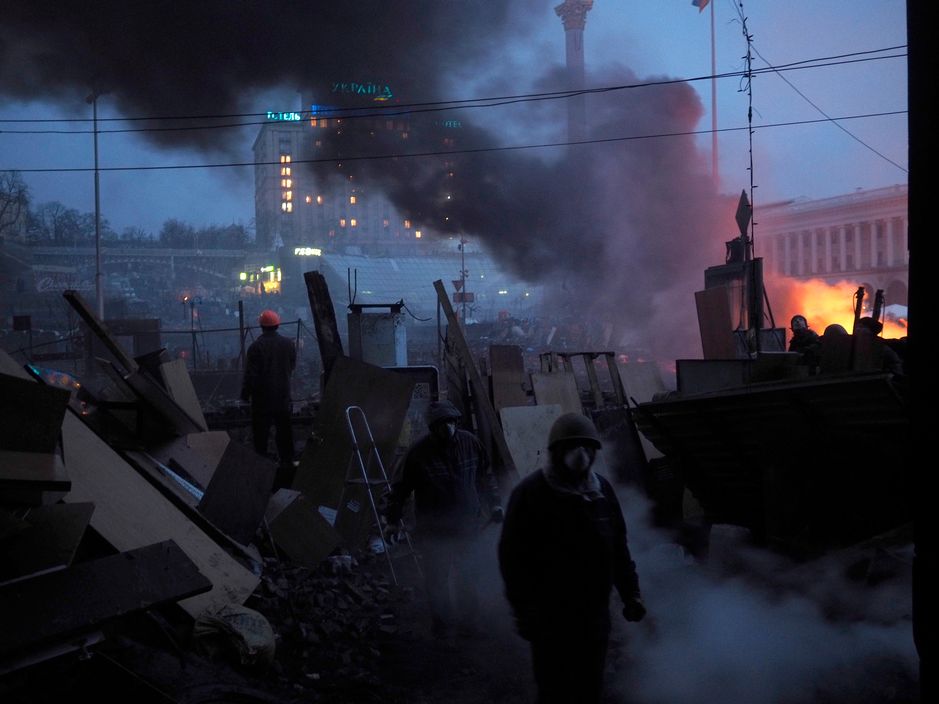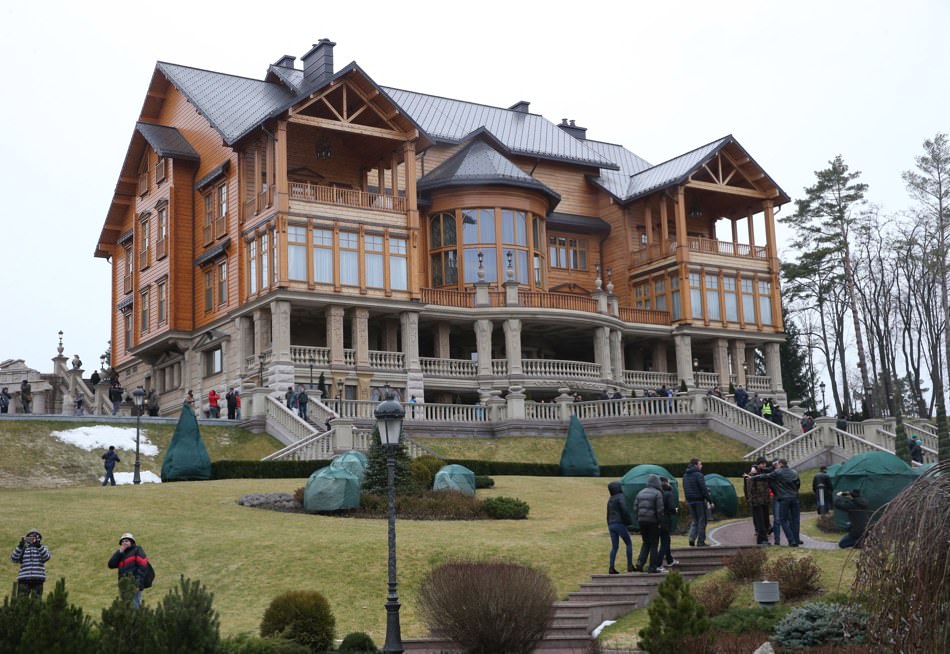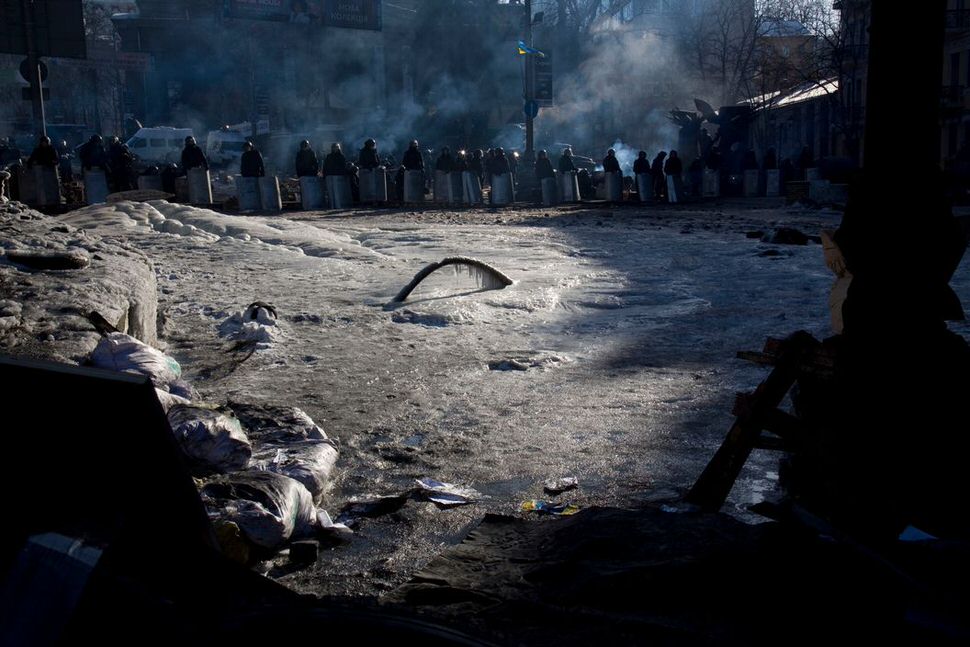From Moscow to London to New York, the Ukrainian revolution has been seen through a haze of propaganda. Russian leaders and the Russian press have insisted that Ukrainian protesters were right-wing extremists and then that their victory was a coup. Ukraine’s president, Viktor Yanukovych, used the same clichés after a visit with the Russian president at Sochi. After his regime was overturned, he maintained he had been ousted by “right-wing thugs,” a claim echoed by the armed men who seized control of airports and government buildings in the southern Ukrainian district of Crimea on Friday.
Interestingly, the message from authoritarian regimes in Moscow and Kiev was not so different from some of what was written during the uprising in the English-speaking world, especially in publications of the far left and the far right. From Lyndon LaRouche’s Executive Intelligence Review through Ron Paul’s newsletter through The Nation and The Guardian, the story was essentially the same: little of the factual history of the protests, but instead a play on the idea of a nationalist, fascist, or even Nazi coup d’état.
In fact, it was a classic popular revolution. It began with an unmistakably reactionary regime. A leader sought to gather all power, political as well as financial, in his own hands. This leader came to power in democratic elections, to be sure, but then altered the system from within. For example, the leader had been a common criminal: a rapist and a thief. He found a judge who was willing to misplace documents related to his case. That judge then became the chief justice of the Supreme Court. There were no constitutional objections, subsequently, when the leader asserted ever more power for his presidency.
In power, this leader, this president, remained a thief, but now on a grand, perhaps even unsurpassed, scale. Throughout his country millions of small businessmen and businesswomen found it impossible to keep their firms afloat, thanks to the arbitrary demands of tax authorities. Their profits were taken by the state, and the autonomy that those profits might have given them were denied. Workers in the factories and mines had no means whatsoever of expression their own distress, since any attempt at a strike or even at labor organization would simply have led to their dismissal.
The country, Ukraine, was in effect an oligarchy, where much of the wealth was in the hands of people who could fit in one elevator. But even this sort of pluralism, the presence of more than one very rich person, was too much for the leader, Viktor Yanukovych. He wanted to be not only the president but the oligarch-in-chief. His son, a dentist, was suddenly one of the wealthiest men in Europe. Tens of billions of dollars simply disappeared from the state budget. Yanukovych built for himself a series of extravagant homes, perhaps the ugliest in architectural history.
It is hard to have all of the power and all of the money at the same time, because power comes from the state, and the state has to have a budget. If a leader steals so much from the people that the state goes bankrupt, then his power is diminished. Yanukovych actually faced this problem last year. And so, despite everything, he became vulnerable, in a very curious way. He needed someone to finance the immediate debts of the Ukrainian state so that his regime would not fall along with it.
Struggling to pay his debts last year, the Ukrainian leader had two options. The first was to begin trade cooperation with the European Union. No doubt an association agreement with the EU would have opened the way for loans. But it also would have meant the risk of the application of the rule of law within Ukraine. The other alternative was to take money from another authoritarian regime, the great neighbor to the east, the Russian Federation.
In December of last year, the leader of this neighboring authoritarian regime, Vladimir Putin, offered a deal. From Russia’s hard currency reserves accumulated by the sale of hydrocarbons he was willing to offer a loan of $15 billion, and lower the price of natural gas from Russia. Putin had a couple of little preoccupations, however.
The first was the gay conspiracy. This was a subject that had dominated Russian propaganda throughout last year but which had been essentially absent from Ukraine. Perhaps Ukraine could join in? Yes indeed: the Ukrainian prime minister began to explain to his population that Ukraine could not have closer cooperation with Europe, since the EU was interested chiefly in gay marriage.
Putin’s second preoccupation was something called Eurasia. This was and is Putin’s proposed rival to the European Union, a club of dictatorships meant to include Russia, Belarus, and Kazakhstan. Again, perhaps Ukraine could join? Yanukovych hesitated here, seeing the trap—the subordination of Ukraine of course meant his own subordination—but he did allow himself to be jollied along toward the necessary policies. He began to act like a proper dictator. He began to kill his own people in significant numbers. He bloodied his hands, making him an unlikely future partner for the European Union.
Advertisement
Enter a lonely, courageous Ukrainian rebel, a leading investigative journalist. A dark-skinned journalist who gets racially profiled by the regime. And a Muslim. And an Afghan. This is Mustafa Nayem, the man who started the revolution. Using social media, he called students and other young people to rally on the main square of Kiev in support of a European choice for Ukraine. That square is called the Maidan, which by the way is an Arab word. During the first few days of the protests the students called it the Euromaidan. Russian propaganda called it, predictably enough, the Gayeuromaidan.
When riot police were sent to beat the students, who came to defend them? More “Afghans,” but “Afghans” of a very different sort: Ukrainian veterans of the Soviet Red Army, men who had been sent to invade Afghanistan during after the Soviet invasion of that country in 1979. These men came to defend “their children,” as they called the students. But they were also defending a protest initiated by a man born in Kabul at the very time they were fighting their way toward it.
In December the crowds grew larger. By the end of the year, millions of people had taken part in protests, all over the country. Journalists were beaten. Individual activists were abducted. Some of them were tortured. Dozens disappeared and have not yet been found. As the New Year began the protests broadened. Muslims from southern Ukraine marched in large numbers. Representatives of the large Kiev Jewish community were prominently represented. Some of the most important organizers were Jews. The telephone hotline that people called to seek missing relatives was established by gay activists (people who have experience with hotlines). Some of the hospital guards who tried to stop the police from abducting the wounded were young feminists.
In all of these ways, the “decadent” West, as Russia’s foreign minister put it, was present. Yes, there were some Jews, and there were some gays, in this revolution. And this was exploited by both the Russian and Ukrainian regimes in their internal propaganda. The Russian press presented the protest as part of a larger gay conspiracy. The Ukrainian regime instructed its riot police that the opposition was led by a larger Jewish conspiracy. Meanwhile, both regimes informed the outside world that the protestors were Nazis. Almost nobody in the West seemed to notice this contradiction.
On January 16, Yanukovych signed a series of laws that had been “passed” through parliament, entirely illegally, by a minority using only a show of hands. These laws, introduced by pro-Russian legislators and similar to Russian models, severely constrained the freedom of speech and assembly, making of millions of protesters “extremists” who could be imprisoned. Organizations that had financial contacts with the outside world, including Catholic and Jewish groups, were suddenly “foreign agents” and subject to immediate harassment.
After weeks of maintaining their calm in the face of repeated assaults by the riot police, some protesters now chose violence. Out of public view, people had been dying at the hands of the police for weeks. Now some of the protesters were killed by the regime in public. The first Ukrainian protester to be killed was an Armenian. The second to be killed was a Belarusian.
Then came the mass killings by the regime. On February 18 the Ukrainian parliament was supposed to consider a compromise that many observers believed was a first step away from bloody confrontation: a constitutional reform to return the state to parliamentary democracy. Instead, the riot police were unleashed in Kiev, this time armed not only with tear gas, stun grenades, and rubber bullets, but also with live ammunition. The protesters fell back to the Maidan and defended it, the way revolutionaries do: with cobblestones, Molotov cocktails, and in the end their bare hands.
On February 20, an EU delegation was supposed to arrive to negotiate a truce. Instead, the regime orchestrated a bloodbath. The riot police fell back from some of the Maidan. When protesters followed, they were shot by snipers who had taken up positions on rooftops. Again and again people ran out to try to rescue the wounded, and again and again they were shot.
Who was killed? Dozens of people, in all about a hundred, most of them young men. Bohdan Solchanyk was a young lecturer at the Ukrainian Catholic University, a Ukrainian speaker from western Ukraine. He was shot and killed. Yevhen Kotlyov was an environmentalist from Kharkiv, a Russian speaker from eastern Ukraine. He was shot and killed. One of the people killed was a Russian citizen; a number of Russians had come to fight—most of them anarchists who had come to aid their Ukrainian anarchist comrades. At least two of those killed by the regime, and perhaps more, were Jews. One of those “Afghans,” Ukrainian veterans of the Red Army’s war in Afghanistan, was Jewish: Alexander Scherbatyuk. He was shot and killed by a sniper. Another of those killed was a Pole, a member of Ukraine’s Polish minority.
Has it ever before happened that people associated with Ukrainian, Russian, Belarusian, Armenian, Polish, and Jewish culture have died in a revolution that was started by a Muslim? Can we who pride ourselves in our diversity and tolerance think of anything remotely similar in our own histories?
The people were victorious as a result of sheer physical courage. The EU foreign ministers who were supposed to be treated to a bloody spectacle saw something else: the successful defense of the Maidan. The horrifying massacre provoked a general sense of outrage, even among some of the people who had been Yanukovych’s allies. He did something he probably had not, when the day began, intended to do: he signed an agreement in which he promised not to use violence. His policemen understood, perhaps better than he, what this meant: the end of the regime. They melted away, and he ran for his life. Power shifted to parliament, where a new coalition of oppositionists and dissenters from Yanukovych’s party formed a majority. Reforms began, beginning with the constitution. Presidential elections were called for May.
Still, the propaganda continued. Yanukovych stopped somewhere to record a video message, in Russian, claiming that he was the victim of a Nazi coup. Russian leaders maintained that extremists had come to power, and that Russians in Ukraine were under threat. Although the constitutional transition is indeed debatable in the details, these charges of a right-wing coup are nonsense.
The Ukrainian far right did play an important part in the revolution. What it did, in going to the barricades, was to liberate itself from the regime of which it had been one of the bulwarks. One of the moral atrocities of the Yanukovych regime was to crush opposition from the center-right, and support opposition from the far right. By imprisoning his major opponents from the legal political parties, most famously Yulia Tymoshenko, Yanukovych was able to make of democracy a game in which he and the far right were the only players.
The far right, a party called Svoboda, grew larger in these conditions, but never remotely large enough to pose a real challenge to the Yanukovych regime in democratic elections. In this arrangement Yanukovych could then tell gullible westerners that he was the alternative to the far right. In fact, Svoboda was a house opposition that, during the revolution, rebelled against its own leadership. Against the wishes of their leaders, the radical youth of Svoboda fought in considerable numbers, alongside of course people of completely different views. They fought and they took risks and they died, sometimes while trying to save others. In the post-revolutionary situation these young men will likely seek new leadership. The leader of Svoboda, according to opinion polls, has little popular support; if he chooses to run for president, which is unlikely, he will lose.
The radical alternative to Svoboda is Right Sector, a group of far-right organizations whose frankly admitted goal was not a European future but a national revolution against all foreign influences. In the long run, Right Sector is the group to watch. For the time being, its leaders have been very careful, in conversations with both Jews and Russians, to stress that their goal is political and not ethnic or racial. In the days after the revolution they have not caused violence or disorder. On the contrary, the subway runs in Kiev. The grotesque residences of Yanukovych are visited by tourists, but they are not looted. The main one is now being used as a base for archival research by investigative journalists.
The transitional authorities were not from the right, or even from the western part of Ukraine, where nationalism is more widespread. The speaker of the parliament and the acting president is a Baptist preacher from southeastern Ukraine. All of the power ministries, where of course any coup-plotter would plant his own people, were led by professionals and Russian speakers. The acting minister of internal affairs was half Armenian and half Russian. The acting minister of defense was of Roma origin.
The provisional authorities are now being supplanted by a new government, chosen by parliament, which is very similar in its general orientation. The new prime minister is a Russian-speaking conservative technocrat. Both of the major presidential candidates in the elections planned for May are Russian speakers. The likely next president, Vitali Klitschko, is the son of a general in the Soviet armed forces, best known in the West as the heavyweight champion boxer. He is a chess player and a Russian speaker. He does his best to speak Ukrainian. It does not come terribly naturally. He is not a Ukrainian nationalist.
As specialists in Russian and Ukrainian nationalism have been predicting for weeks, the claim that the Ukrainian revolution is a “nationalist coup,” as Yanukovych, in Russian exile, said on Friday, has become a pretext for Russian intervention. This now appears to be underway in the Crimea, where the Russian flag has been raised over the regional parliament and gunmen have occupied the airports. Meanwhile, Russia has put army battle groups on alert and sent naval cruisers from the Baltic Sea to the Black Sea.
Whatever course the Russian intervention may take, it is not an attempt to stop a fascist coup, since nothing of the kind has taken place. What has taken place is a popular revolution, with all of the messiness, confusion, and opposition that entails. The young leaders of the Maidan, some of them radical leftists, have risked their lives to oppose a regime that represented, at an extreme, the inequalities that we criticize at home. They have an experience of revolution that we do not. Part of that experience, unfortunately, is that Westerners are provincial, gullible, and reactionary.
Thus far the new Ukrainian authorities have reacted with remarkable calm. It is entirely possible that a Russian attack on Ukraine will provoke a strong nationalist reaction: indeed, it would be rather surprising if it did not, since invasions have a way of bringing out the worst in people. If this is what does happen, we should see events for what they are: an entirely unprovoked attack by one nation upon the sovereign territory of another.
Insofar as we have accepted the presentation of the revolution as a fascist coup, we have delayed policies that might have stopped the killing earlier, and helped prepare the way for war. Insofar as we wish for peace and democracy, we are going to have to begin by getting the story right.
This is the second installment of Timothy Snyder’s series on Russian ideology and the Ukrainian revolution. In the next part, Snyder examines Putin’s intentions in Crimea.





